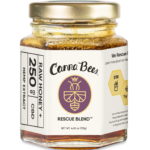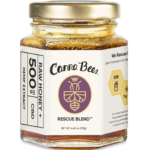Between February and March each year, almond trees burst into bloom in preparation for pollination. What you might already know is that honeybees are absolutely essential for pollinating the almond orchards in California. As the trees blossom, honeybees forage for pollen and nectar. When the bees move from blossom to blossom and tree to tree, they pollinate along the way. Each fertilized flower will grow into an almond.
What you might not know is that honeybees and beekeepers benefit as much from almond trees as the almonds benefit from them.

ALMOND BLOOMS HAPPEN JUST IN TIME
In the same way that almonds are a nutritious snack for humans, almond pollen is very nutritious for honeybees, providing them with all 10 of the essential amino acids their diets require. The relatively early seasonal bloom of Almonds provides a strong source of nutrients before other flowering plants come alive each year. Hives routinely leave the almond orchards stronger than when they arrived.
Even as beekeepers move around in search of higher pollen and nectar yields, winter always inevitably takes a toll. Historically, beekeepers have expected around 15 percent of their colonies to die from October to April because of the cold temperatures and lack of winter forage. Loss rates have almost doubled to 28% since the early 2000s due to a combination of forage loss, pests, diseases and pesticide exposure.
Almond pollination helps in a big way to recoup these losses, resulting in the strong relationships between almond growers and their beekeepers, which often go back years or even generations. Thriving healthy hives can be split into two, allowing bees to proliferate in numbers and beekeepers to grow their apiaries and honey yield. Despite the higher winter honeybee mortality rate, honeybee numbers grow in the spring and summer with the assistance of the almond bloom.
ECONOMICS OF BEEKEEPING
California’s almond industry is worth an estimated 21 billion dollars to California’s economy. And in fact, almonds are also vital to the health of many American beekeeping operations due to the fact that almond pollination accounts for more than a third of all income for beekeepers in the United States. No crop needs honey bees more than California almonds. And likewise, no single crop matters more to beekeepers’ bottom lines than California almonds.
Most of us do not think of honeybees as livestock. We tend to imagine them buzzing around flowers in the wild, minding their own business until we occasionally get in the way of their stingers. However, for the majority of honey bee colonies in the United States, thinking of them as livestock would be the best characterization. Beekeepers manage their colonies to produce honey, wax, pollen and propolis. Beekeepers also provide pollination services for more than 90 crops in the United States alone.

The more than 20,000 beekeepers in the U.S. differ in how they operate, but a typical migratory pattern for commercial honeybees might go as follows: The beekeeping year begins in January waiting for almonds to bloom in California. Once almond bloom is over, the beekeeper moves colonies up through the Pacific Northwest pollinating apples and other spring-blooming crops. In May, the beekeeper takes the colonies to North Dakota to produce honey from clover, canola and sunflowers. As honey production slows in the fall, the beekeeper traditionally returns to Texas, Florida or California to await almond pollination in January, and the cycle begins all over again.

MONOCULTURE ISN’T IDEAL
There is always room for improvement in any system and almond pollination is no different. There are a lot of critics that believe using honey bees for almond pollination is detrimental for the bees. Like all bees, honeybees thrive in a biodiverse landscape. California’s almond industry places them in a monoculture of almond trees and even though the trees provide everything a honey bee colony needs to thrive, there are periods of time before and after the bloom where there is no forage for miles in any direction. Some growers have recognized this issue and have started planting a diverse mix of native flowering plants in between the almond trees to not only nourish the honeybees while they wait for the almond trees to bloom but to also promote native pollinators as well.
HARMFUL PESTICIDES
Most herbicides and pesticides used individually in almond farming are relatively harmless to honeybees. The problem happens when growers mix herbicides and pesticides together with substances called adjuvants. Adjuvants enhance the performance of pesticides by making them spread more evenly and penetrate the leaves of plants.
Eric Mussen, a bee expert at the University of California-Davis explains, “It’s possible that the bees’ own skin tissues had been blocking the pesticides – until the new-and-improved adjuvants gave them a pathway inside.”
Farmers will need to strike a better balance between protecting their crops from other pests while maintaining an optimal environment for the honey bees.

BEST ALMOND POLLINATING PRACTICES
In order for the economics of almond farming to continue to thrive, farmers recognize that we have to continue to have healthy honeybees. All parties recognize that precautionary measures must become the standard in order to ensure almond harvests continue to be a safe place for bees. Here are some of the precautions that farmers and beekeepers are beginning to follow:
- Improved communication about pest control decisions should occur between all pollination stakeholders
- Farmers should provide a Pesticide Plan to beekeepers explicitly outlining any pesticides that will be used
- Beekeepers should play a role in determining hive placement and removal
- Farmers should contact beekeepers 48 hours before pesticide applications
- Farmers should avoid applying insecticides during bloom
- Any fungicide application deemed absolutely necessary during bloom should occur in the late afternoon or evening, when bees and pollen are not present
- Provide clean water for the bees to drink
- Do not spray hives with any pesticide application
- After bloom, when nutrients are no longer available, relocate the honeybees to a new diverse food source.
Bee thankful for honeybees and their keepers. It’s hard to overestimate the importance of California almonds to the stability of U.S. beekeeping operations and the invaluable pollination they provide. We just need to make sure all parties involved are following best beekeeping management practices to ensure that the almond harvests remain symbiotic to Almond trees, Honeybees, Farmers, Beekeepers and Consumers. At Bee Delightful, we practice the highest ethical standards with our bees, exclusively practicing treatment-free beekeeping. Our bees express Varroa Sensitive Hygiene (VSH) and are capable of defending themselves naturally against pests that carry devastating viruses and other diseases. Fortunately, our apiaries are dense in seasonal flowers and nutritious pollen and our beekeepers thrive economically from queen-rearing and honey production. These genetically-resilient queen bees are the first step in ensuring the successful commercial migratory patterns for other commercial honeybee operations.






